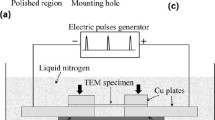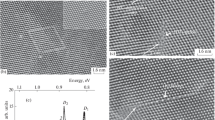Abstract
Punched-out dislocations emitted from an octahedral oxide precipitate in single-crystal silicon were investigated using high-voltage electron microscopy and tomography (HVEM-tomography) to understand the mechanism of softening caused by the oxide precipitates. In the present paper, direct evidence of the transition of a punched-out prismatic dislocation loop to a slip dislocation is presented. The punched-out dislocation grows into a large matrix dislocation loop by absorption of interstitial atoms, which were produced during oxide precipitation.
Similar content being viewed by others
References
A. Borghesi, B. Pivac, A. Sassella, and A. Stella: Oxygen precipitation in silicon. J. Appl. Phys. 77, 4169 (1995).
K. Sueoka, N. Ikeda, T. Yamamoto, and S. Kabayashi: Morphology change of oxide precipitates in CZ silicon during 2-step annealing. J. Electrochem. Soc. 141, 3588 (1994).
K. Jurkschat, S. Senkader, and P.R. Wilshaw: Onset of slip in silicon containing oxide precipitates. J. Appl. Phys. 90, 3219 (2001).
A. Giannattasio, S. Senkader, R.J. Falster, and P.R. Wilshaw: The role of prismatic dislocation loops in the generation of glide dislocations in Cz-silicon. Commit. Mater. Sci. 30, 131 (2004).
I. Yonenaga and K. Sumino: Mechanical behavior of Czochralski -silicon crystals as affected by precipitation and dissolution of oxygen atoms. Jon. J. Appl. Phys. 21, 47 (1982).
B. Leroy and C. Plougonven: Warpage of silicon wafers. J. Electrochem. Soc. 127, 961 (1980).
K. Yashutake, M. Umeno, and H. Kawabe: Mechanical properties of heat-treated Czochralski-grown silicon crystals. Appl. Phys. Lett. 37, 787 (1980).
R. Behrensmeier, M. Brede, and P. Haasen: The influence of precipitated oxygen on the brittle-ductile transition of silicon. Scr. Metall. 21, 1581 (1987).
K. Sueoka, M. Akatsuka, and H. Katahama: Dependence of mechanical strength of Czochralski silicon wafers on temperature of oxygen precipitation annealing. J. Electrochem. Soc. 144, 1111 (1997).
J.S. Barnard, J. Sharp, J.R. Tong, and P.A. Midgley: High-resolution three-dimensional imaging of dislocations. Science 313, 319 (2006).
J.H. Sharp, J.S. Barnard, K. Kaneko, K. Higashida, and P.A. Midgley: Dislocation tomography made easy: A reconstruction from ADF STEM images obtained using automated image shift correction. J. Phys. Conf. Ser. 126, 012013 (2008).
M. Tanaka, K. Higashida, K. Kaneko, S. Hata, and M. Mitsuhara: Crack tip dislocations revealed by electron tomography in silicon single crystal. Scr. Mater. 59, 901 (2008).
F.A. Ponce and S. Hahn: Structure of thermally-induced microdefects in Czochralski silicon, in Electron Microscopy of Materials, edited by W.A. Krakow, D.A. Smith, and L.W. Hobbs (Mater. Res. Soc. Symp. Proc. 31, North-Holland, New York, 1984), p. 153.
J.P. Hirth and J. Lothe: Theory of Dislocations (McGraw-Hill, New York, 1986).
G.E. Dieter: Mechanical Metallurgy, 2nd ed. (McGraw-Hill Book Company, New York, 1976).
M. Tanaka, S. Sadamatsu, G.L. Liu, H. Nakamura, K. Hgashida, and I.M. Robertson: Sequential multiplication of dislocation sources along a crack front revealed by HVEM-tomography. J. Mater. Res. (submitted).
T.Y. Tan and W.K. Tice: Oxygen precipitation and the generation of dislocations in silicon. Philos. Mae. 34, 615 (1976).
T.Y. Tan: Exigent-accommodation volume of precipitation and formation of oxygen precipitates in silicon, in Oxygen, Carbon, Hydrogen and Nitrogen in Crystalline Silicon, edited by J.C. Mikkelsen, Jr., S.J. Pearton, J.W. Corbett, and S.J. Penny cook (Mater. Res. Soc. Symp. Proc. 59, Pittsburgh, PA, 1986), p. 269.
Author information
Authors and Affiliations
Corresponding author
Additional information
This author was an editor of this journal during the review and decision stage. For the JMR policy on review and publication of manuscripts authored by editors, please refer to http://www.mrs.org/jmr_policy
Rights and permissions
About this article
Cite this article
Tanaka, M., Liu, G.S., Kishida, T. et al. Transition from a punched-out dislocation to a slip dislocation revealed by electron tomography. Journal of Materials Research 25, 2292–2296 (2010). https://doi.org/10.1557/jmr.2010.0308
Received:
Accepted:
Published:
Issue Date:
DOI: https://doi.org/10.1557/jmr.2010.0308




